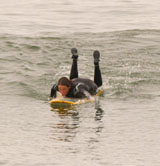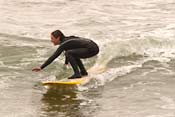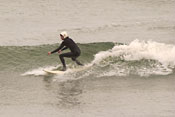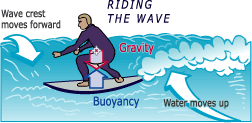|
|

The
Science of Surfing
page 2

|
|
When
you push on the water, the water exerts an equal and opposite
force on you, accelerating you to a speed necessary to catch
a wave.
|
Get
a Move On
Wave Speed
Looking out, you see a wave. A nice roller, moving
toward you at a constant speed. You know from experience that when
it reaches you it will be traveling about six knots (approximately
seven miles per hour). You start to paddle forward, accelerating
up to a speed that will allow you to catch the wave. Judging which
wave to catch—and the exact timing needed to paddle out to
catch it—is one skill a surfer must develop. The physics here
is simple: You push water towards the back of the board with your
hands. By Newton’s law of action and reaction (the third law
of motion), the water pushes on you in the opposite direction, moving
you forward and accelerating you up to speed.

|
|
As
the surfer catches the wave, the water pushes the surfboard
forward. At last, the net force isn’t zero! The net force
accelerates the surfer to the speed of the wave and beyond.
|
The Ride Begins
As the wave reaches you, the surface of the water begins to tip
upward. Think about that—liquid water sloping at an angle!
This can only happen because the water is in motion. You can see
the water move in a wave by watching bits of seaweed or foam accelerate
up the front of the wave. As the water rises under you, you find
yourself on a slippery slope. Gravity is pulling you down that slope,
buoyancy is pushing you up, and new forces—hydrodynamic forces
(forces exerted by a moving fluid) resulting from the interaction
of moving water and the surfboard—push you forward.

|
|
Notice
how Lori reaches from a deep crouch to touch the moving water
of the wave. She’s riding a longboard, which floats high
in the water.
|
Hydrodynamic Forces:
Feel Me, See Me
A great deal of the complexity of surfing is hidden within the hydrodynamic
forces, the forces exerted on the surfboard by moving water. The
next time you’re in a boat or sitting next to a rushing stream
(and can safely do so), put your hand in the water perpendicular
to the direction in which it’s moving. Feel the forces that
the water exerts on your hand. Then tip your hand to the right,
and feel the force push your hand further to the right. Watch the
flow of water deflect to the left as it collides with your hand.
In the same way, water moving up the front of a wave collides with
the surfboard and is deflected. You can see the result of the collision
by watching the spray of water squirting out around the edges of
the surfboard.

|
|
Eric,
on a shortboard, is taking a ride down the face of a wave. He’s
ahead of the break, in balance, with knees bent. A surfer moving
along the face of a wave can travel at a speed faster than the
wave itself.
|

|
|
Once
the surfer is up to speed on the wave, all of the hydrodynamic
forces of the moving water on the surfboard add up to oppose
gravity, resulting in a zero net force.
|
The hydrodynamic forces
also include drag forces as water slides along the bottom of the
surfboard. The hydrodynamic forces are potentially quite large,
as any surfer who has fallen under a breaking wave can attest. Very
subtle shaping of the bottom of the surfboard can strongly affect
the performance of the board. Channels, concavities, and curves
imposed on the bottom of a surfboard that can hardly be seen or
felt without comparing them to a straightedge can change the hydrodynamic
forces on the board substantially.
As you ride a wave, you
savor the rush of acceleration as tons of moving water pushes you
faster and faster. You stand up on the board with your knees bent,
hanging loose. You balance side-to-side and front-to-back, keeping
the continuously changing forces and torques in balance. In a sense,
you are dancing with the hydrodynamic forces.
The Wave Breaks
As the wave moves into shallower water, it begins to interact more
with the sandy bottom of the sea. The lower part of the wave slows,
while the top keeps moving forward, so the wave steepens and breaks.
You don’t want to be broken, especially considering that every
cubic meter of water weighs a ton. But if you’ve chosen a good
surfing location, the wave doesn’t close out and break all
at once. Instead, it peels left to right, or right to left. By leaning
the board to the side, you can steer so that you stay on the wave
just ahead of the break on the steepest part of the wave, the shoulder.
(Eric is doing this in the above photo.)
As Eric and other surfers
know, riding the waves lets you play with energy. By dropping down
the face of the wave (pulled by gravity), you gain kinetic energy,
the energy of motion. At the same time, you lose gravitational potential
energy, the energy of being high. Then, by turning up the face of
the wave, you can trade back the energy of motion for potential
energy as you rise to the crest of the wave. Turning up and down
the face of a wave is the soul of surfing.
|

|






